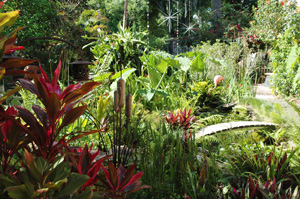





Creating a water and wetland area is one of the quickest ways to attract wildlife into your garden. Dig a pond and almost immediately the water will become home to beetles, water snails and water boatmen. Add a boggy area of planting nearby and frogs and toads will appear to lay their eggs in the pond and take up residence nearby. A pond also allows the introduction of yellow water iris, purple loosestrife and meadowsweet.
 It is worth taking a little time to plan your pond rather than just digging a hole, lining it and filling it with water. First find the right site. Water is normally found in low-lying areas, so look for a low point in the garden; you should ideally choose a place where there is a background of a hedge or shrubs so that animals can approach the water under cover of planting. Select a sunny, sheltered site on level ground, if possible, away from overhanging trees, which will quickly fill up the pond with leaves in autumn, to the detriment of its inhabitants. If there are small children in the family, consider the possibility of fencing off the pond at least until the children are old enough for the open water not to be a safety problem.
It is worth taking a little time to plan your pond rather than just digging a hole, lining it and filling it with water. First find the right site. Water is normally found in low-lying areas, so look for a low point in the garden; you should ideally choose a place where there is a background of a hedge or shrubs so that animals can approach the water under cover of planting. Select a sunny, sheltered site on level ground, if possible, away from overhanging trees, which will quickly fill up the pond with leaves in autumn, to the detriment of its inhabitants. If there are small children in the family, consider the possibility of fencing off the pond at least until the children are old enough for the open water not to be a safety problem.
Make the pond as large as space will allow and design gently sloping sides for easy access by birds and mammals to the water’s edge. The centre of the pond should be at least 75cm (30in) deep in order to prevent the pond freezing solid in winter or overheating in the summer.
Many preformed rigid ponds have very steep sides and are not really suitable for wildlife, so it is more sensible to create your pond using a flexible liner.
Any new body of water will attract algae — small organisms that cover the surface with an ugly greenish ‘blanketweed’. Planting the pond will help to control algae, since the plants will compete with the algae for light and nutrients. The algae may take control to begin with, but avoid using chemicals and allow the plants to do the job. This may mean physically removing some of the algae in the first season.
Water beetles, water snails and other pond life will arrive of its own accord, although you may wish to import a few snails as a start. Many pond-owners will wish to include some fish, and these will have to be brought in from outside sources such as friends’ ponds or pet stores. A wildlife pond should be stocked with native fish. Some species of sticklebacks and minnow are small enough to enjoy living in a garden pond and feeding on small insects, including mosquito larvae, and algae. Be careful if you want goldfish because they are carnivorous and love eating tadpoles and other smaller pond inhabitants.
Copyright © www.100flowers.win Botanic Garden All Rights Reserved